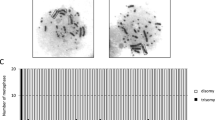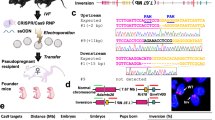Abstract
Recent advances in chromosome engineering and the potential for downstream applications in gene therapy were presented at the Artificial Chromosome Session of Genome Medicine: Gene Therapy for the Millennium in Rome, Italy in September 2001. This session concentrated primarily on the structure and function of human centromeres and the ongoing challenge of equipping human artificial chromosomes (HACs) with centromeres to ensure their mitotic stability. Advances in the ‘bottom up’ construction of HACs included the transfer into HT1080 cells of circular PACs containing alpha satellite DNA, and the correction of HPRT deficiency in cells using HACs. Advances in the ‘top down’ construction of HACs using telomere associated chromosome fragmentation in DT40 cells included the formation of HACs that are less than a megabase in size and transfer of HACs through the mouse germline. Significant progress has also been made in the use of human minichromosomes for stable trans-gene expression. While many obstacles remain towards the use of HACs for gene therapy, this session provided an optimistic outlook for future success.
This is a preview of subscription content, access via your institution
Access options
Subscribe to this journal
Receive 12 print issues and online access
$259.00 per year
only $21.58 per issue
Buy this article
- Purchase on Springer Link
- Instant access to full article PDF
Prices may be subject to local taxes which are calculated during checkout




Similar content being viewed by others
References
Farr C et al. Functional reintroduction of human telomeres into mammalian cells Proc Natl Acad Sci USA 1991 88: 7006–7010
Hanish JP, Yanowitz JL, de Lange T . Stringent sequence requirements for the formation of human telomeres Proc Natl Acad Sci USA 1994 91: 8861–8865
Gilbert DM . Making sense of eukaryotic DNA replication origins Science 2001 294: 96–100
Willard HF . Centromeres: the missing link in the development of human artificial chromosomes Curr Opin Genet Dev 1998 8: 219–225
Harrington JJ et al. Formation of de novo centromeres and construction of first-generation human artificial microchromosomes Nat Genet 1997 15: 345–355
Ikeno M et al. Construction of YAC-based mammalian artificial chromosomes Nat Biotechnol 1998 16: 431–439
Ebersole TA et al. Mammalian artificial chromosome formation from circular alphoid input DNA does not require telomere repeats Hum Mol Genet 2000 9: 1623–1631
Masumoto H et al. Assay of centromere function using a human artificial chromosome Chromosoma 1998 107: 406–416
Henning KA et al. Human artificial chromosomes generated by modification of a yeast artificial chromosome containing both human alpha satellite and single- copy DNA sequences Proc Natl Acad Sci USA 1999 96: 592–597
Schueler MG et al. Genomic and genetic definition of a functional human centromere Science 2001 294: 109–115
Raimondi E et al. Gene targeting to the centromeric DNA of a human minichromosome Hum Gene Ther 1996 7: 1103–1109
Guiducci C et al. Use of a human minichromosome as a cloning and expression vector for mammalian cells Hum Mol Genet 1999 8: 1417–1424
Auriche C, Donini P, Ascenzioni F . Molecular and cytological analysis of a 5.5 Mb minichromosome EMBO Rep 2001 2: 102–107
Tomizuka K et al. Functional expression and germline transmission of a human chromosome fragment in chimaeric mice Nat Genet 1997 16: 133–143
Tomizuka K et al. Double trans-chromosomic mice: maintenance of two individual human chromosome fragments containing Ig heavy and kappa loci and expression of fully human antibodies Proc Natl Acad Sci USA 2000 97: 722–727
Kuroiwa Y et al. Manipulation of human minichromosomes to carry greater than megabase-sized chromosome inserts Nat Biotechnol 2000 18: 1086–1090
Voet T et al. Efficient male and female germline transmission of a human chromosomal vector in mice Genome Res 2001 11: 124–136
Kereso J et al. De novo chromosome formations by large-scale amplification of the centromeric region of mouse chromosomes Chromosome Res 1996 4: 226–239
Csonka E et al. Novel generation of human satellite DNA-based artificial chromosomes in mammalian cells J Cell Sci 2000 113: 3207–3216
Co DO et al. Generation of transgenic mice and germline transmission of a mammalian artificial chromosome introduced into embryos by pronuclear microinjection Chromosome Res 2000 8: 183–191
de Jong G et al. Efficient in vitro transfer of a 60-Mb mammalian artificial chromosome into murine and hamster cells using cationic lipids and dendrimers Chromosome Res 2001 9: 475–485
Henikoff S, Ahmad K, Malik HS . The centromere paradox: stable inheritance with rapidly evolving DNA Science 2001 293: 1098–1102
Larin Z, Fricker MD, Tyler-Smith C . De novo centromere formation following introduction of a Y alphoid YAC into mammalian cells Hum Mol Genet 1994 3: 689–695
Warburton PE, Cooke HJ . Hamster chromosomes containing amplified human alpha-satellite DNA show delayed sister chromatid separation in the absence of de novo kinetochore formation Chromosoma 1997 106: 149–159
Sullivan BA, Schwartz S . Identification of centromeric antigens in dicentric Robertsonian translocations: CENP-C and CENP-E are necessary components of functional centromeres Hum Mol Genet 1995 5: 2189–2198
Warburton PE et al. Molecular cytogenetic analysis of eight inversion duplications of human chromosome 13q that each contain a neocentromere Am J Hum Genet 2000 66: 1794–1806
Choo KHA . Domain rganization at the centromere and neocentromere Dev Cell 2001 1: 165–177
Warburton PE . Epigenetic analysis of kinetochore assembly on variant human centromeres Trends Genet 2001 17: 243–247
Sullivan BA, Blower MD, Karpen GH . Determining centromere identity: cyclical stories and forking paths Nat Rev Genet 2001 2: 584–596
Sullivan KF . A solid foundation: functional specialization of centromeric chromatin Curr Opin Genet Dev 2001 11: 182–188
Mejia JE, Larin Z . The assembly of large BACs by in vivo recombination Genomics 2000 70: 165–170
Mejia JE et al. Functional complementation of a genetic deficiency with human artificial chromosomes Am J Hum Genet 2001 69: 315–326
Grimes BR et al. Stable gene expression from a mammalian artificial chromosome EMBO Rep 2001 2: 910–914
Mills W et al. Generation of an approximately 2.4 Mb human X centromere-based minichromosome by targeted telomere-associated chromosome fragmentation in DT40 Hum Mol Genet 1999 8: 751–761
Yang JW et al. Human mini-chromosomes with minimal centromeres Hum Mol Genet 2000 9: 1891–1902
Kuroiwa Y et al. Efficient modification of a human chromosome by telomere-directed truncation in high homologous recombination-proficient chicken DT40 cells Nucleic Acids Res 1998 26: 3447–3448
Shen MH et al. Human mini-chromosomes in mouse embryonal stem cells Hum Mol Genet 1997 6: 1375–1382
Shen MH et al. The accuracy of segregation of human mini-chromosomes varies in different vertebrate cell lines, correlates with the extent of centromere formation and provides evidence for a trans-acting centromere maintenance activity Chromosoma 2001 109: 524–535
Shen MH et al. A structurally defined mini-chromosome vector for the mouse germ line Curr Biol 2000 10: 31–34
Saffery R et al. Construction of neocentromere-based human minichromosomes by telomere-associated chromosomal truncation Proc Natl Acad Sci USA 2001 98: 5705–5710
Smith AJH et al. A site-directed chromosomal translocation induced in embryonic stem cells by Cre-loxP recombination Nat Genet 1995 9: 376–385
Willard HF . Genomics and gene therapy. Artificial chromosomes coming to life Science 2000 290: 1308–1309
Choo KH . Engineering human chromosomes for gene therapy studies Trends Mol Med 2001 7: 235–237
Acknowledgements
We would like to thank meeting participants Hunt Willard, Bala Balakumaran, Katie Rudd and Roger Slee for valuable discussions.
Author information
Authors and Affiliations
Rights and permissions
About this article
Cite this article
Grimes, B., Warburton, P. & Farr, C. Chromosome engineering: prospects for gene therapy. Gene Ther 9, 713–718 (2002). https://doi.org/10.1038/sj.gt.3301763
Published:
Issue Date:
DOI: https://doi.org/10.1038/sj.gt.3301763
Keywords
This article is cited by
-
De novo formed satellite DNA-based mammalian artificial chromosomes and their possible applications
Chromosome Research (2015)
-
Introduction of a CD40L genomic fragment via a human artificial chromosome vector permits cell-type-specific gene expression and induces immunoglobulin secretion
Journal of Human Genetics (2008)
-
Exogenous gene expression and growth regulation of hematopoietic cells via a novel human artificial chromosome
Journal of Human Genetics (2006)
-
Increased missegregation and chromosome loss with decreasing chromosome size in vertebrate cells
Chromosoma (2006)
-
Genetic modification of hematopoietic stem cells with nonviral systems: past progress and future prospects
Gene Therapy (2005)



